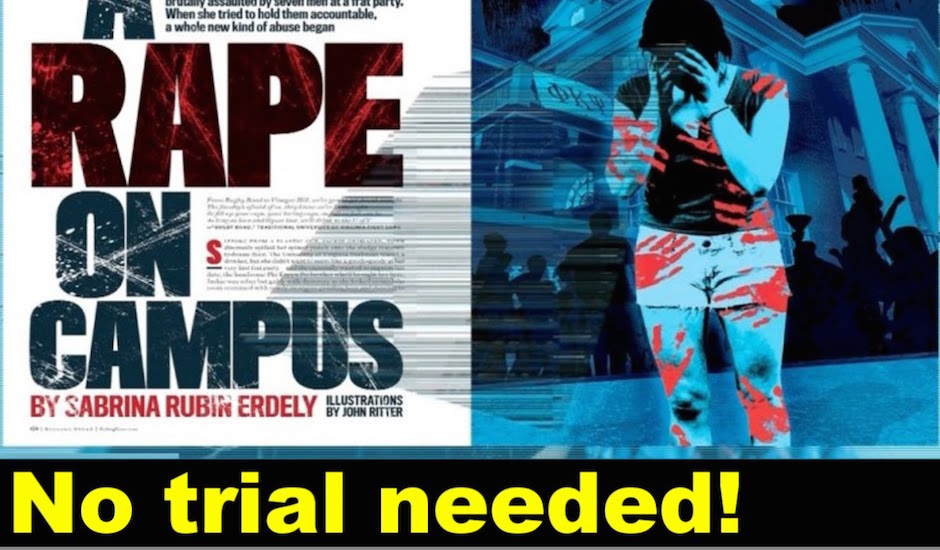 Online Employment ScamsAnd navigating that minefield so you may actually find work.
Online Employment ScamsAnd navigating that minefield so you may actually find work.

Rolling Stone's Rape On Campus Article & Journalism
In the age of online journalism, has something as simple as fact-checking gone out the window?
On November 19 last year, Rolling Stone published an article titled A Rape on Campus: A Brutal Assault and Struggle for Justice at UVA. It’s an immediately eye-catching title, and one that wedges itself deeply in part of the zeitgeist of American, and in essence international, colleges and universities. The story basically revolves around a person named “Jackie”, a student at the University of Virginia whose actual identity is still not public information.
It’s a harrowing tale. It details an apparent hazing process that Jackie was the victim of, orchestrated by a member of a popular, nation-wide fraternity. According to the article, she was raped seven times by pledges to the fraternity, while her “date” (named Drew in the article) and another watched on and coached them. “Don’t you want to be a brother?” Drew’s quoted as saying. The whole story reads like a college-themed horror movie or think-piece docudrama. Like many, my first reaction to the article was, “How can something like this happen, and only be exposed in a Rolling Stone article?” Well, as we’ve discovered now, it didn’t happen.
Rolling Stone published the article after months of conversation between Jackie and Sabrina Erdely, a staff writer who had been frequently publishing with RS since 2008. Her articles mostly covered various acts of crime, including sexual assaults in the military and weed deals by Beverly Hills debutantes. A Rape On Campus is written in the standard long-form style of Rolling Stone current affairs pieces: a paragraph or two of juicy content, then a whole lot of context and backstory, and then the specific details of the event. But this is where the story begins to fall apart, because the article contains exactly one source: Jackie herself. Now, the very first thing they teach you in journalism school, and for that matter throughout your entire career, is that if you’re going to take on a solid and controversial journalistic subject, you need to cover all bases when it comes to sourcing. This was completely lacking in Erdely’s story, and immediately set off red flags among the industry. Writer and blogger Richard Bradley noted his issues with the article six months ago, addressing his experience with fake journalism and the power of pre-existing biases. But more on that in a bit.
A few days ago, the Columbia University School of Graduate Journalism published a response to the RS article after months of research and, probably, debate over journalistic ethics, with dean and Pulitzer Prize-winning journalist Steve Coll taking the reigns. It’s damning, and it pretty much backs up Bradley’s original trepidations. Published by RS as an in-house response to their own article, managing editor Will Dana addresses the whole experience as “painful reading” but at the same time “a fascinating document — a piece of journalism, as Coll describes it, about a failure of journalism.” Coll had full access to Erdely’s notes and recordings, and the full editorial detail from the RS offices. It’s hard to see it as anything more than a token effort, however, given the lack of commitment from RS to address what is obviously a failing in their journalistic practice. And that’s the scary part, because when an international magazine as arguably respected as Rolling Stone messes up so classically, there’s issues that need to be addressed in the entire industry.
The passage of a story from idea to publication is a layered process. After research, interviewing, compilation and eventually drafting, the journalist will file the story with their office. It then passes through various stages of sub-editing – in an ideal situation, around three or four subs, which include proofing, fact-checking and content editing – before reaching the editors. When it comes to a full-feature article, it’s usually expected that more than one editor will green-light it before publication. So, in essence, a proper newsroom will have a number of checks and balances in place to prevent fictitious or inaccurate stories from reaching print. Apparently, very little of this happened with the Rape On Campus story.
Erdely’s article is full of inaccuracies. In March, the Charlottesville Police Department announced that there were no leads available to pursue after a four-month investigation of the original article. The man who Jackie quoted as the alleged mastermind did not exist: according to her (now ex) friends, Jackie had previously named another man who was in her chemistry class. That person was found to have not been able to be in the same place as the alleged rape. And then there’s Jackie’s apparent secrecy towards Erdely. Both the original article and the response are peppered with mysterious denials and refusals from Jackie on information that you’d think would be integral to the story. But, again, this is a story of emotion and reaction, and emotion often and unfortunately beats common sense in dangerous circumstances.
Therein lies the big issue – beyond any one person’s fault – that lead to the article being published: it was so tied into a construct of ennui and stigma we build around people like the stereotypical “rich, white, preppy boys” that inhabit colleges and universities. It’s a story that has appeared in countless books and movies, and it’s built on a culture of fear. Fear of secret societies, fear of the recklessness of youth, fear of the power granted to certain individuals, especially men over women. It’s not too hard to believe the story, which at least lends some credence to just how it could’ve gotten this far.

The fallout from the story is far-reaching and destructive. The University Of Virginia and the fraternity involved suffered innumerable threats, protests and sleights against them, all from one unfounded accusation. According to Steven Scipione, chapter president of Phi Kappa Psi - the fraternity in question, “It's completely destroyed a semester of our lives, specifically mine. It's put us in the worst position possible in our community here, in front of our peers and in the classroom." Erdely’s reputation as a journalist is most likely ruined. She’s been a regular contributor to GQ, Self, The New Yorker and others as well as Rolling Stone, but it’s hard to see her getting work with many of them after this. But more than anything, there’s two dangerously polarising ethical issues that we probably won’t get over for a while: false rape allegations – which is entirely different story - and the indelible hole made in the space between writer and reader that exposes the ever-growing vulnerability of the media industry.
Both Coll and Bradley have addressed that, had the RS newsroom been one 15 years ago, it’s more likely the issue could’ve been avoided. Both are respected journalists end editors, and both coincidentally mention the “old days” of completely print-based journalism and the age-old system that was set up to accommodate it. We don’t have that luxury anymore. The editors at RS know as much as anyone that there is constant, knife-edge pressure applied from the now-immediate news cycle and society’s hunger for instantaneous information. It’s clear that, given enough time and scrutiny, the story would either have been heavily altered or dismissed entirely, because the failures in practice that lead to its publication were not just avoidable, but were easy to avoid. How difficult is it to find out if a certain fraternity member even exists? Or if anyone out of a room of nine people not including the alleged victim, were actual people? How about any witnesses at the party? How about the leadership of the fraternity, or the university, or any of Jackie’s friends? These should’ve all been critical issues for Erdely and RS’s editorial team, but they were forgotten in the face of the emotional impact of the story and the generally no-time-to-stop-and-think scenario modern media has become.
The editor of The Wall Street Journal’s Law Blog, Ashby Jones, sums up the issue pretty succinctly from an old-guard publication point of view:
“They’ve done studies on blogs that show two of the quickest ways to lose readers are to post too much or post too little. So you’re constantly trying to put up the right number of items every day. And most of the time you don’t run the risk of putting up too much because you’re busy, so you run the risk of not putting up enough – and so when you have something, you want to put it up quickly. And sometimes there’s breaking news in there – and it’s hard, and getting harder and harder with blogs and other online news outlets, to be the first to break news. S you’re constantly battling competing impulses: On the one hand, you want to be the first to get something up; on the other, you’ve got to make sure that everything adheres to the rigorous sort of ethical standards the Journal abides by. And so that is something I feel pretty acutely – and that, I think, is one of the bigger challenges to me.”
It’s clear that Rolling Stone were feeling the pressures of immediacy when they published Erdely’s story. When they commissioned her to write it, there were already a number of high-profile rape cases at universities around the country, including Yale, Harvard, Columbia, Vanderbilt and Florida State. It would be completely unfair to assume that Rolling Stone wanted to jump on the bandwagon when it came to the tragedy of alleged rape on college campuses, but it is fair to say that the magazine, and Erdely, wished to express a point of view on what was a very controversial subject. The essence of journalism has always been about giving the readers what they want, albeit with an angle they might not have thought about. This, in essence, is what Rolling Stone were doing, and to my mind they got caught up in the immediate impact of the story without questioning whether or not there was enough factual evidence. This is not just speculation, either: both Coll and Dana directly addressed the obvious faults in RS’s procedure that came from a lack of thoughtful process. An extremely critical pessimist may even look upon Coll’s RS-published response as a cheap way to cash in on their own mistake, but I think it’s much deeper than that. I think Dana and the entire RS editorial team are now taking a chance to stand up and address the white elephant in the room: that current journalistic practice is either suffering under the pressures of new technology, or is too archaic and old-minded for the current state of media. Or both.
Jon Ronson, the guy behind The Men Who Stare At Goats and The Psychopath Test, recently published a book called So You’ve Been Publicly Shamed, which details various people’s experiences with being demonized through mass media. It begins with the popularity of public shaming in Colonial America, and ends around now, when Justine Sacco (the “Going to Africa. Hope I don’t get AIDS. Just kidding, I’m white!” journalist) and, in a very current boost to book sales, the Rolling Stone Virginia University fiasco. His general angle seems to be that public shaming, and the media’s ability to accentuate such shaming, isn’t a new thing. What is new is the ability of practically anyone to denounce a story that is untrue. And this occurs if only for the immediate and unavoidable accessibility of anything that’s published, if it has any online presence. This is extremely healthy for the journalism industry, as it works as yet another check against faulty journalistic practice. But it is always, as Ashby Jones says, tempered by the fact that the internet age is an age of now. Journalists today are caught between the necessity of journalistic ethics and the immediacy of the daily news cycle, and ultimately their audience’s attention spans.
The word that has been bandied around pretty frequently in the conversation of the Virginia University is “avoidable”. It’s clear in everyone’s mind that it would’ve been a very simple thing to avoid this mistake. More than that, it would have been adhering to the standards of journalistic ethics that were established more than a century ago. But, like so many things, we’re now finding that those old cornerstones are crumbling away, and it’s up to the current industry to catch up the exponential growth of new media. If this whole issue teaches us anything, it shouldn’t be that standards are slipping. It should instead be that there is a new standard, and that journalists, editors and even the audience have a responsibility to adapt.
This article was originally published on Cam's Blog: thereaddeaf.wordpress.com
 Online Employment ScamsAnd navigating that minefield so you may actually find work.
Online Employment ScamsAnd navigating that minefield so you may actually find work.
 Instagram Is A Cult(But I'm hooked on the Kool-Aid)
Instagram Is A Cult(But I'm hooked on the Kool-Aid)